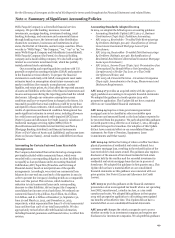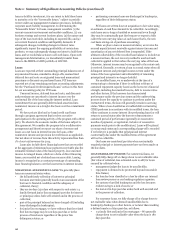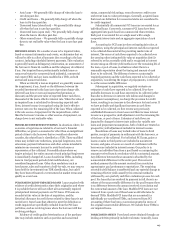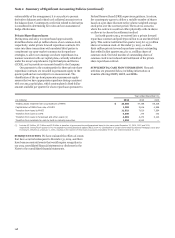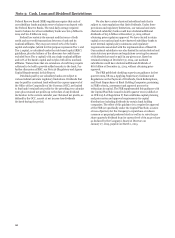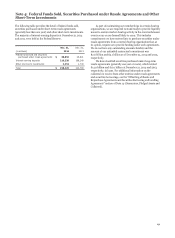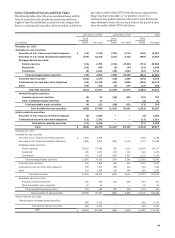Wells Fargo 2014 Annual Report Download - page 149
Download and view the complete annual report
Please find page 149 of the 2014 Wells Fargo annual report below. You can navigate through the pages in the report by either clicking on the pages listed below, or by using the keyword search tool below to find specific information within the annual report.Accordingly, these fair value estimates may not be realized in an
actual sale or immediate settlement of the asset or liability.
We incorporate lack of liquidity into our fair value
measurement based on the type of asset or liability measured
and the valuation methodology used. For example, for certain
residential MHFS and certain securities where the significant
inputs have become unobservable due to illiquid markets and
vendor or broker pricing is not used, we use a discounted cash
flow technique to measure fair value. This technique
incorporates forecasting of expected cash flows (adjusted for
credit loss assumptions and estimated prepayment speeds)
discounted at an appropriate market discount rate to reflect the
lack of liquidity in the market that a market participant would
consider. For other securities where vendor or broker pricing is
used, we use either unadjusted broker quotes or vendor prices or
vendor or broker prices adjusted by weighting them with
internal discounted cash flow techniques to measure fair value.
These unadjusted vendor or broker prices inherently reflect any
lack of liquidity in the market, as the fair value measurement
represents an exit price from a market participant viewpoint.
Where markets are inactive and transactions are not
orderly, transaction or quoted prices for assets or liabilities in
inactive markets may require adjustment due to the uncertainty
of whether the underlying transactions are orderly. For items
that use price quotes in inactive markets, we analyze the degree
of market inactivity and distressed transactions to determine the
appropriate adjustment to the price quotes.
We continually assess the level and volume of market
activity in our investment security classes in determining
adjustments, if any, to price quotes. Given market conditions can
change over time, our determination of which securities markets
are considered active or inactive can change. If we determine a
market to be inactive, the degree to which price quotes require
adjustment, can also change. See Note 17 (Fair Values of Assets
and Liabilities) for discussion of the fair value hierarchy and
valuation methodologies applied to financial instruments to
determine fair value.
Derivatives and Hedging Activities
We recognize all derivatives on the balance sheet at fair value.
On the date we enter into a derivative contract, we designate the
derivative as (1) a hedge of the fair value of a recognized asset or
liability, including hedges of foreign currency exposure (“fair
value hedge”), (2) a hedge of a forecasted transaction or of the
variability of cash flows to be received or paid related to a
recognized asset or liability (“cash flow hedge”), or (3) held for
trading, customer accommodation or asset/liability risk
management purposes, including economic hedges not
qualifying for hedge accounting. For a fair value hedge, we
record changes in the fair value of the derivative and, to the
extent that it is effective, changes in the fair value of the hedged
asset or liability attributable to the hedged risk, in current period
earnings in the same financial statement category as the hedged
item. For a cash flow hedge, we record changes in the fair value
of the derivative to the extent that it is effective in OCI, with any
ineffectiveness recorded in current period earnings. We
subsequently reclassify these changes in fair value to net income
in the same period(s) that the hedged transaction affects net
income in the same financial statement category as the hedged
item. For derivatives not designated as a fair value or cash flow
hedge, we report changes in the fair values in current period
noninterest income.
For fair value and cash flow hedges qualifying for hedge
accounting, we formally document at inception the relationship
between hedging instruments and hedged items, our risk
management objective, strategy and our evaluation of
effectiveness for our hedge transactions. This includes linking all
derivatives designated as fair value or cash flow hedges to
specific assets and liabilities on the balance sheet or to specific
forecasted transactions. Periodically, as required, we also
formally assess whether the derivative we designated in each
hedging relationship is expected to be and has been highly
effective in offsetting changes in fair values or cash flows of the
hedged item using the regression analysis method.
We discontinue hedge accounting prospectively when (1) a
derivative is no longer highly effective in offsetting changes in
the fair value or cash flows of a hedged item, (2) a derivative
expires or is sold, terminated or exercised, (3) we elect to
discontinue the designation of a derivative as a hedge, or (4) in a
cash flow hedge, a derivative is de-designated because it is not
probable that a forecasted transaction will occur.
When we discontinue fair value hedge accounting, we no
longer adjust the previously hedged asset or liability for changes
in fair value, and cumulative adjustments to the hedged item are
accounted for in the same manner as other components of the
carrying amount of the asset or liability. If the derivative
continues to be held after fair value hedge accounting ceases, we
carry the derivative on the balance sheet at its fair value with
changes in fair value included in earnings.
When we discontinue cash flow hedge accounting and it is
not probable that the forecasted transaction will not occur, the
accumulated amount reported in OCI at the de-designation date
continues to be reported in OCI until the forecasted transaction
affects earnings. If cash flow hedge accounting is discontinued
and it is probable the forecasted transaction will not occur, the
accumulated amount reported in OCI at the de-designation date
is immediately recognized in earnings. If the derivative
continues to be held after cash flow hedge accounting ceases, we
carry the derivative on the balance sheet at its fair value with
future changes in fair value included in earnings.
We may purchase or originate financial instruments that
contain an embedded derivative. At inception of the financial
instrument, we assess (1) if the economic characteristics of the
embedded derivative are not clearly and closely related to the
economic characteristics of the financial instrument (host
contract), (2) if the financial instrument that embodies both the
embedded derivative and the host contract is not measured at
fair value with changes in fair value reported in earnings, and (3)
if a separate instrument with the same terms as the embedded
instrument would meet the definition of a derivative. If the
embedded derivative meets all of these conditions, we separate it
from the host contract by recording the bifurcated derivative at
fair value and the remaining host contract at the difference
between the basis of the hybrid instrument and the fair value of
the bifurcated derivative. The bifurcated derivative is carried at
fair value with changes recorded in current period earnings.
By using derivatives, we are exposed to counterparty credit
risk, which is the risk that counterparties to the derivative
contracts do not perform as expected. If a counterparty fails to
perform, our counterparty credit risk is equal to the amount
reported as a derivative asset on our balance sheet. The amounts
reported as a derivative asset are derivative contracts in a gain
position, and to the extent subject to legally enforceable master
netting arrangements, net of derivatives in a loss position with
the same counterparty and cash collateral received. We minimize
counterparty credit risk through credit approvals, limits,
monitoring procedures, executing master netting arrangements
and obtaining collateral, where appropriate. To the extent
derivatives subject to master netting arrangements meet the
applicable requirements, including determining the legal
147




